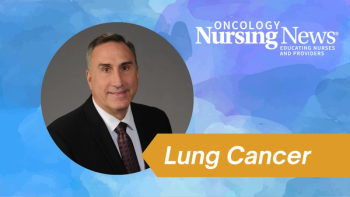
Myeloprotective Benefit of CDK4/6 Inhibition in ES-SCLC
Edgardo Santos, MD, FACP, and Martin Dietrich, MD, PhD, share insights into the mechanism of action of CDK4/6 inhibitors for the prevention of myelosuppression in ES-SCLC.
Episodes in this series

Transcript:
Edgardo Santos, MD, FACP: Dr Dietrich, can you explain the use of CDK4/6 inhibitor trilaciclib [Cosela] in providing prophylaxis for chemotherapy-induced myelosuppression in the setting of small cell lung cancer?
Martin Dietrich, MD, PhD: That has a very interesting mechanism. The cyclin-dependent kinases are involved in cell cycle progression. We’ve seen this in clinical trials. For breast cancer treatment, CDK4/6 inhibitors are common because they’re among the most common, predictable effects is myelosuppression. This is typically a cyclin-dependent kinase 6–mediated effect. As 1 of the resistance mechanisms, this is where the idea was born to use CDK4/6 inhibitors in breast cancer. When using CDK6 in breast cancer treatment, RB, the retinoblastoma protein—which that has a major guardian function in conjunction with TP53—is lost. In small cell lung cancer, TP53-RB dual mutations are essentially a genotypic definition of small cell lung cancer.
You already have a histology that informs that about the genotype. We know that these patients have impairments in the retinoblastoma protein through mutations, therefore making it very interesting for patients with small-cell lung cancer. You can stop the cell cycle progression in the bone marrow by inhibiting CDK4 and CDK6¾particularly with trilaciclib [Cosela]—but you’re not affecting possible cell cycle progression. One concern is that if we arrest cell cycle, do we have static with a cytotoxic drug in conjunction? As it turns out, based on the molecular differentiator of RB presence, the bone marrow acts very differently and can be protected through cell cycle arrest, while the small cell tumor cells continue to proliferate uninhibitedly by CDK4/6 inhibition. There’s no impact on small cell lung cancer, making it a very refined approach to protect the bone marrow. It doesn’t affect the treatment of small cell lung cancer, allowing organ-specific supportive care.
Edgardo Santos, MD, FACP: Exactly. The beauty of arresting, as you mentioned, those stem cells in the G1 [growth 1] phase of the mitosis cycle, is avoiding those hematopoietic stem cells from moving forward; meanwhile, the patient receives chemotherapy. That’s the beautiful thing going on with supporting our patient with cancer¾trying to avoid this myelosuppression and a lot of problems, for not only the patient but also the caregivers, family, and others.
Martin Dietrich, MD, PhD: Another aspect, biologically, is protecting the wide cell lineage. We’re using, in almost all patients, combination immunotherapy up front and preserving the white blood cell population. There’s a biological rationale that we may positively affect the impact of immunotherapy. It’s not what we’re protecting against, but it’s certainly 1 we hope we can promote by maintaining an improved white blood cell count.
Edgardo Santos, MD, FACP: Correct. We’re talking about white blood cell count, but by arresting the hematopoietic stem cells, we also impact the red blood cells, the platelets, and the megakaryocyte lineage. We’ll discuss this more in clinical stories, but basically, we’re impacting not only neutropenia but also anemia and thrombocytopenia.
Martin Dietrich, MD, PhD: Absolutely.
Transcript edited for clarity.
Newsletter
Knowledge is power. Don’t miss the most recent breakthroughs in cancer care.
















































































